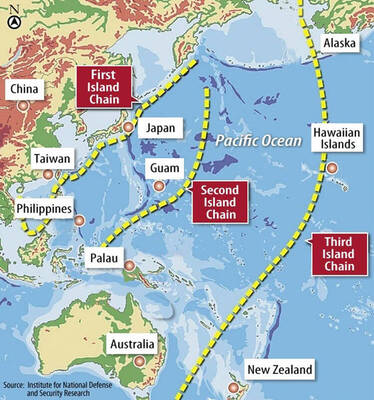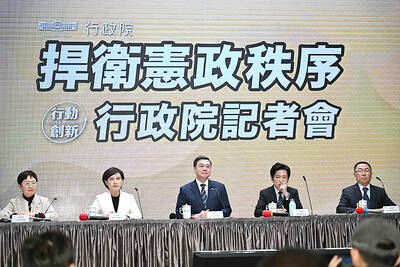The battle over the Fourth Nuclear Power Plant has shifted from the legislative and executive branches of government to the Control Yuan, as members of the country's watchdog for public officials vowed to speed up their investigation into the Cabinet's Oct. 27 decision to halt construction of the plant.
While the Cabinet announced on Wednesday that the project, which was interrupted for almost four months, would proceed, the future of the plant is far from secure.
"The political responsibility that should be shouldered by the officials involved is not our concern. We [the five-member special task force of the Control Yuan] will focus on the legal aspects of the decision-making process. That is, whether the decision was reached in accordance with the law," said Lin Shih-chi (
Lin went on to dismiss rumors that the resumption of construction of the power plant would affect the Control Yuan's decision.
"Our determination to make an impartial ruling ... has never been shaken. It is also unfair to make any speculation at the moment as the first meeting will not be held until next week."
Lin said that although no definite timetable had been set, they would proceed as quickly as possible.
In related news, disenchanted by the Cabinet's giving ground to renew the power plant's construction, anti-nuclear groups yesterday appealed to the Control Yuan, claiming that the government had failed to conduct a new environmental impact assessment (EIA) for the power plant, given that the specifications for the reactors had changed since the initial EIA was approved.
The petitioners said that the Cabinet was irresponsible to allow further construction of the plant as a significant increase to the planned power output of the reactor had been made, but not officially approved by the relevant government agency.
According to Kao Cheng-yen (
Kao pointed out that the government departments in charge had been censured in the past by the Control Yuan for failure to follow proper procedures, but so far no compensatory measures had been taken.
Government agencies also came under attack for failing to reassess the plant's earthquake resistance, as well as failing to find a proper site for the nuclear waste it would generate.
In response to the attacks, Control Yuan member Kang Ning-hsiang (
"Citing the change to the power output of the reactor, for example, how could such a vast change be made without a safety assessment being made beforehand" Kang said. "The assessment has to be done, and it needs to be done in accordance with an even stricter standard."

The US government has signed defense cooperation agreements with Japan and the Philippines to boost the deterrence capabilities of countries in the first island chain, a report by the National Security Bureau (NSB) showed. The main countries on the first island chain include the two nations and Taiwan. The bureau is to present the report at a meeting of the legislature’s Foreign Affairs and National Defense Committee tomorrow. The US military has deployed Typhon missile systems to Japan’s Yamaguchi Prefecture and Zambales province in the Philippines during their joint military exercises. It has also installed NMESIS anti-ship systems in Japan’s Okinawa

‘WIN-WIN’: The Philippines, and central and eastern European countries are important potential drone cooperation partners, Minister of Foreign Affairs Lin Chia-lung said Minister of Foreign Affairs Lin Chia-lung (林佳龍) in an interview published yesterday confirmed that there are joint ventures between Taiwan and Poland in the drone industry. Lin made the remark in an exclusive interview with the Chinese-language Liberty Times (the Taipei Times’ sister paper). The government-backed Taiwan Excellence Drone International Business Opportunities Alliance and the Polish Chamber of Unmanned Systems on Wednesday last week signed a memorandum of understanding in Poland to develop a “non-China” supply chain for drones and work together on key technologies. Asked if Taiwan prioritized Poland among central and eastern European countries in drone collaboration, Lin

NO CONFIDENCE MOTION? The premier said that being toppled by the legislature for defending the Constitution would be a democratic badge of honor for him Premier Cho Jung-tai (卓榮泰) yesterday announced that the Cabinet would not countersign the amendments to the local revenue-sharing law passed by the Legislative Yuan last month. Cho said the decision not to countersign the amendments to the Act Governing the Allocation of Government Revenues and Expenditures (財政收支劃分法) was made in accordance with the Constitution. “The decision aims to safeguard our Constitution,” he said. The Constitution stipulates the president shall, in accordance with law, promulgate laws and issue mandates with the countersignature of the head of the Executive Yuan, or with the countersignatures of both the head of the Executive Yuan and ministers or

CABINET APPROVAL: People seeking assisted reproduction must be assessed to determine whether they would be adequate parents, the planned changes say Proposed amendments to the Assisted Reproduction Act (人工生殖法) advanced yesterday by the Executive Yuan would grant married lesbian couples and single women access to legal assisted reproductive services. The proposed revisions are “based on the fundamental principle of respecting women’s reproductive autonomy,” Cabinet spokesperson Michelle Lee (李慧芝) quoted Vice Premier Cheng Li-chiun (鄭麗君), who presided over a Cabinet meeting earlier yesterday, as saying at the briefing. The draft amendment would be submitted to the legislature for review. The Ministry of Health and Welfare, which proposed the amendments, said that experts on children’s rights, gender equality, law and medicine attended cross-disciplinary meetings, adding that